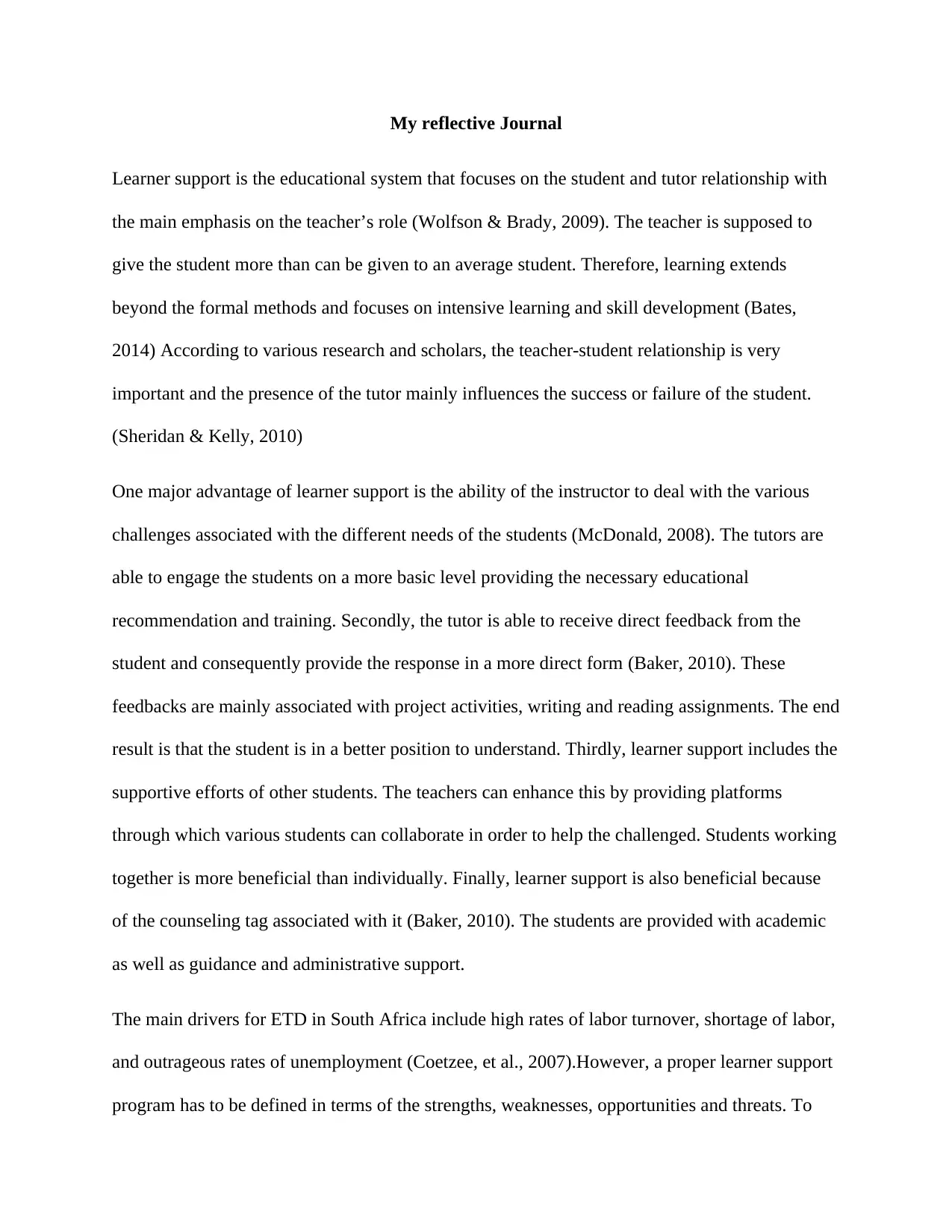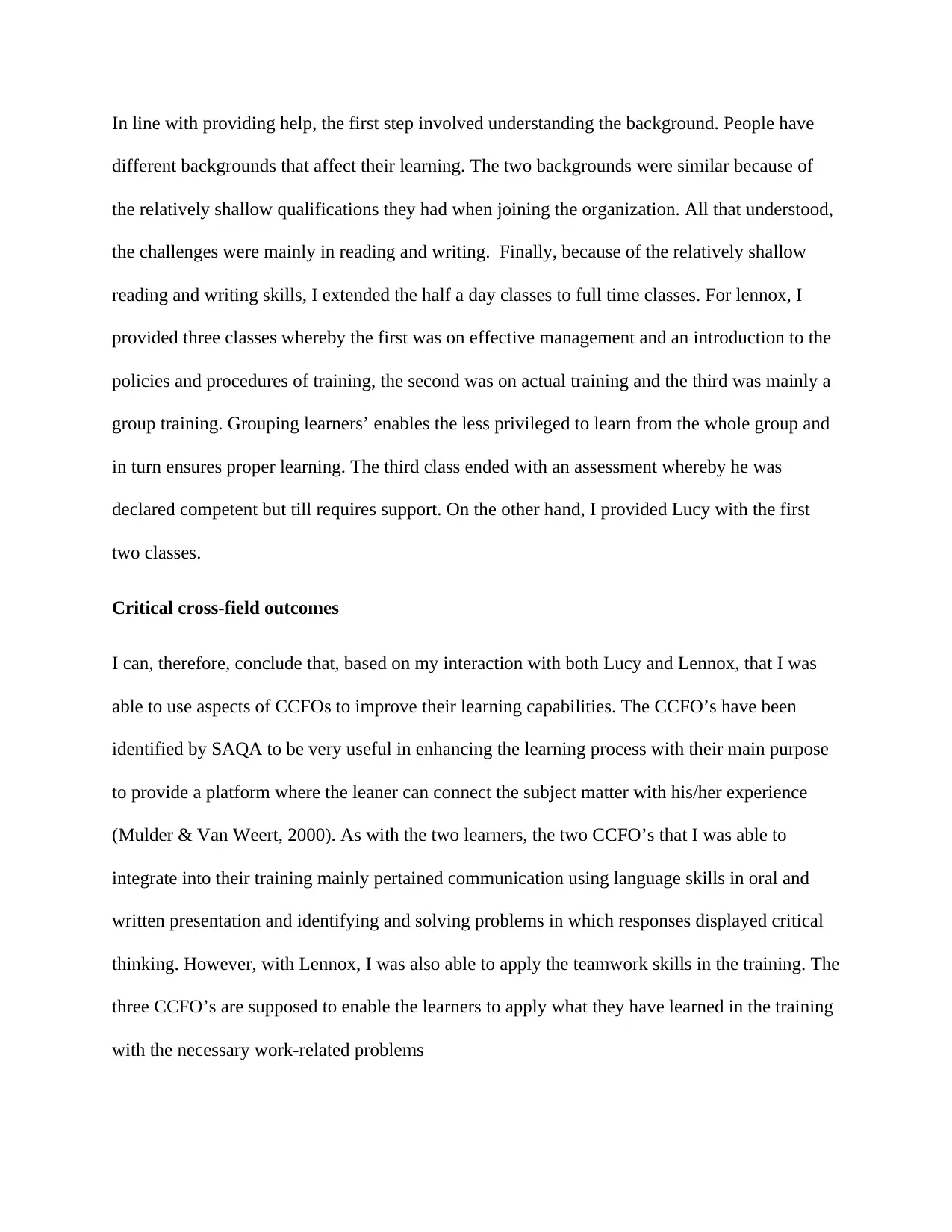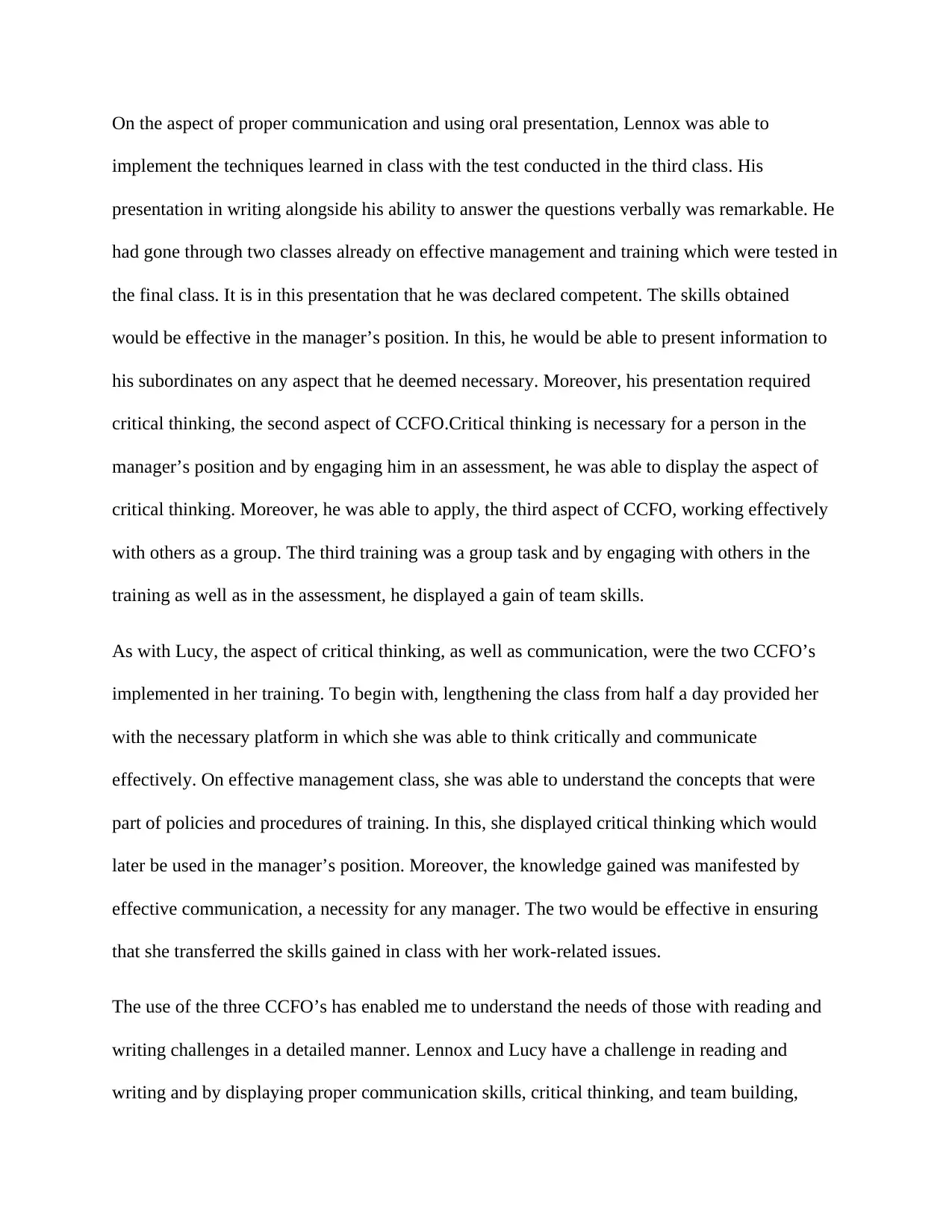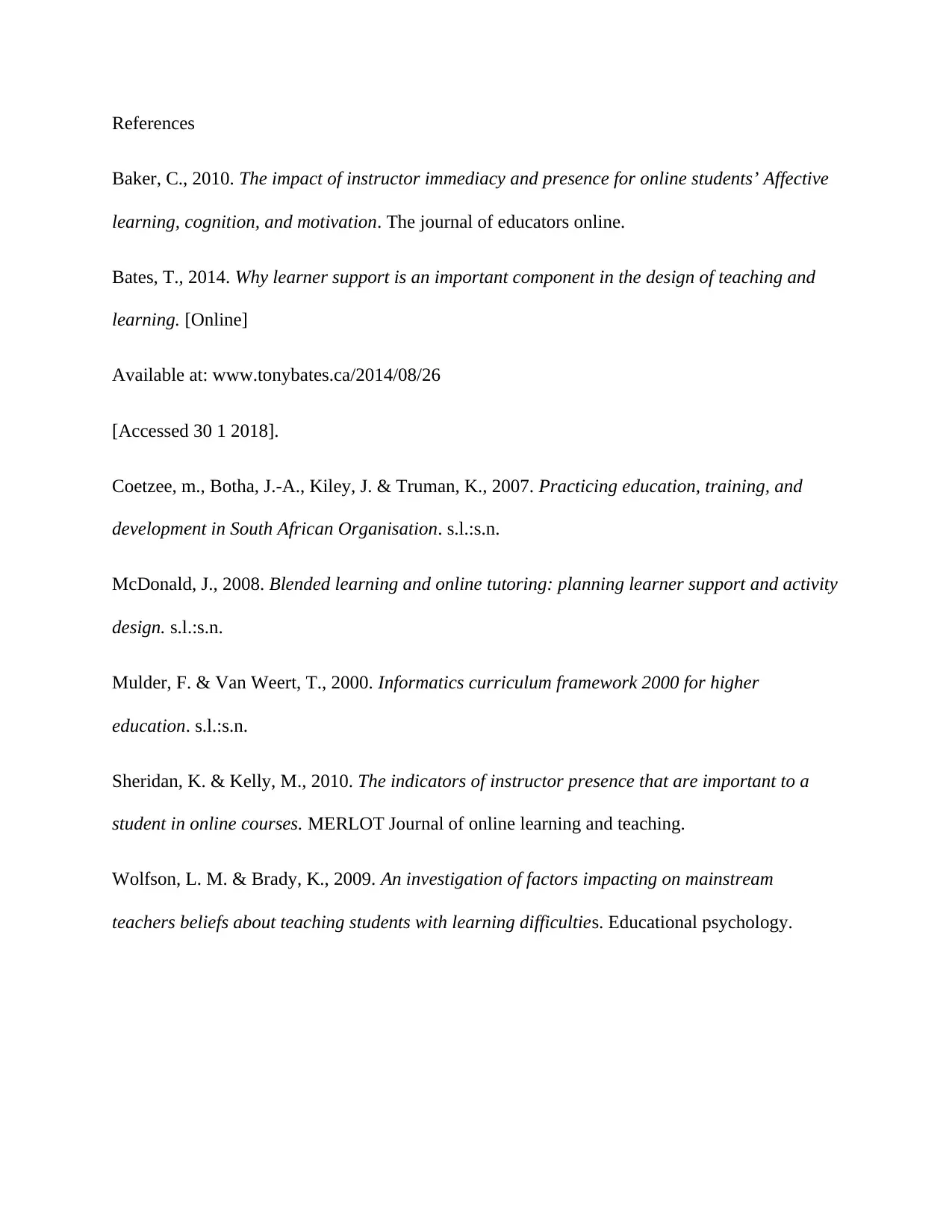Reflective Journal: Learner Support in Professional Development
VerifiedAdded on 2020/05/16
|6
|1681
|91
Journal and Reflective Writing
AI Summary
This reflective journal entry explores the concept of learner support within a professional development context. The author discusses the importance of the teacher-student relationship and its influence on student success, highlighting the benefits of individualized instruction and direct feedback. The journal details the author's experience in providing learner support to two colleagues, Lucy Mathuloane Kumane and Lennox Mkhonto, who faced reading and writing challenges. The author describes the methods used, including extended class schedules, one-on-one tutoring, and group training sessions. The journal then analyzes the application of Critical Cross-Field Outcomes (CCFOs) in the training process, emphasizing communication skills, critical thinking, and teamwork. The author concludes by reflecting on the effectiveness of these strategies in improving the colleagues' management skills and addressing their specific learning needs. The paper references various academic sources to support the analysis.

My reflective Journal
Learner support is the educational system that focuses on the student and tutor relationship with
the main emphasis on the teacher’s role (Wolfson & Brady, 2009). The teacher is supposed to
give the student more than can be given to an average student. Therefore, learning extends
beyond the formal methods and focuses on intensive learning and skill development (Bates,
2014) According to various research and scholars, the teacher-student relationship is very
important and the presence of the tutor mainly influences the success or failure of the student.
(Sheridan & Kelly, 2010)
One major advantage of learner support is the ability of the instructor to deal with the various
challenges associated with the different needs of the students (McDonald, 2008). The tutors are
able to engage the students on a more basic level providing the necessary educational
recommendation and training. Secondly, the tutor is able to receive direct feedback from the
student and consequently provide the response in a more direct form (Baker, 2010). These
feedbacks are mainly associated with project activities, writing and reading assignments. The end
result is that the student is in a better position to understand. Thirdly, learner support includes the
supportive efforts of other students. The teachers can enhance this by providing platforms
through which various students can collaborate in order to help the challenged. Students working
together is more beneficial than individually. Finally, learner support is also beneficial because
of the counseling tag associated with it (Baker, 2010). The students are provided with academic
as well as guidance and administrative support.
The main drivers for ETD in South Africa include high rates of labor turnover, shortage of labor,
and outrageous rates of unemployment (Coetzee, et al., 2007).However, a proper learner support
program has to be defined in terms of the strengths, weaknesses, opportunities and threats. To
Learner support is the educational system that focuses on the student and tutor relationship with
the main emphasis on the teacher’s role (Wolfson & Brady, 2009). The teacher is supposed to
give the student more than can be given to an average student. Therefore, learning extends
beyond the formal methods and focuses on intensive learning and skill development (Bates,
2014) According to various research and scholars, the teacher-student relationship is very
important and the presence of the tutor mainly influences the success or failure of the student.
(Sheridan & Kelly, 2010)
One major advantage of learner support is the ability of the instructor to deal with the various
challenges associated with the different needs of the students (McDonald, 2008). The tutors are
able to engage the students on a more basic level providing the necessary educational
recommendation and training. Secondly, the tutor is able to receive direct feedback from the
student and consequently provide the response in a more direct form (Baker, 2010). These
feedbacks are mainly associated with project activities, writing and reading assignments. The end
result is that the student is in a better position to understand. Thirdly, learner support includes the
supportive efforts of other students. The teachers can enhance this by providing platforms
through which various students can collaborate in order to help the challenged. Students working
together is more beneficial than individually. Finally, learner support is also beneficial because
of the counseling tag associated with it (Baker, 2010). The students are provided with academic
as well as guidance and administrative support.
The main drivers for ETD in South Africa include high rates of labor turnover, shortage of labor,
and outrageous rates of unemployment (Coetzee, et al., 2007).However, a proper learner support
program has to be defined in terms of the strengths, weaknesses, opportunities and threats. To
Paraphrase This Document
Need a fresh take? Get an instant paraphrase of this document with our AI Paraphraser

begin with, learner support has been viewed as a way of enhancing the skills and capability of
the human resource in an organization. This is useful because of the lack of skilled labor. As a
matter of fact, it been applied in both the informal sectors in South Africa. On the other hand, the
major threat is attributed to the cost of EDT initiatives. They are very expensive and as such, the
practitioners are required to deliver their EDT interventions in a strategized manner (Coetzee, et
al., 2007).
The major strength lies on the cost saving measures that are employed.EDT initiatives reduces
the expenditure by enabling the human resource teams to continue working during training. On
the other hand, weakness may lie on the ability to effectively manage classes as well as the
training. The training employed has to consider the individual needs and If the needs of the
individuals are not considered, the system may be ineffective.
In my case, I have had the privilege of helping out some of my colleagues at work. Helping out
these individuals entails proper planning, discussion, and training. The major problem observed
with these two individuals, Lucy Mathuloane Kumane and lennox Mkhonto, is on their reading
and writing. The problem was mainly associated with their educational background where both
started as sales assistant working their way to the manager’s positions. The situation is
aggravated by the fact that they have very low educational qualifications, grade 7 to be precise.
Therefore, they are constantly faced with the challenge of reading and writing. This can be a
thorn in the flesh during training because some of the time I had to help them out with the
training. Therefore, I had to ensure that I provided learner support tuition which were mainly one
on one, and more to this, extended the half class schedule to full day schedule.
the human resource in an organization. This is useful because of the lack of skilled labor. As a
matter of fact, it been applied in both the informal sectors in South Africa. On the other hand, the
major threat is attributed to the cost of EDT initiatives. They are very expensive and as such, the
practitioners are required to deliver their EDT interventions in a strategized manner (Coetzee, et
al., 2007).
The major strength lies on the cost saving measures that are employed.EDT initiatives reduces
the expenditure by enabling the human resource teams to continue working during training. On
the other hand, weakness may lie on the ability to effectively manage classes as well as the
training. The training employed has to consider the individual needs and If the needs of the
individuals are not considered, the system may be ineffective.
In my case, I have had the privilege of helping out some of my colleagues at work. Helping out
these individuals entails proper planning, discussion, and training. The major problem observed
with these two individuals, Lucy Mathuloane Kumane and lennox Mkhonto, is on their reading
and writing. The problem was mainly associated with their educational background where both
started as sales assistant working their way to the manager’s positions. The situation is
aggravated by the fact that they have very low educational qualifications, grade 7 to be precise.
Therefore, they are constantly faced with the challenge of reading and writing. This can be a
thorn in the flesh during training because some of the time I had to help them out with the
training. Therefore, I had to ensure that I provided learner support tuition which were mainly one
on one, and more to this, extended the half class schedule to full day schedule.

In line with providing help, the first step involved understanding the background. People have
different backgrounds that affect their learning. The two backgrounds were similar because of
the relatively shallow qualifications they had when joining the organization. All that understood,
the challenges were mainly in reading and writing. Finally, because of the relatively shallow
reading and writing skills, I extended the half a day classes to full time classes. For lennox, I
provided three classes whereby the first was on effective management and an introduction to the
policies and procedures of training, the second was on actual training and the third was mainly a
group training. Grouping learners’ enables the less privileged to learn from the whole group and
in turn ensures proper learning. The third class ended with an assessment whereby he was
declared competent but till requires support. On the other hand, I provided Lucy with the first
two classes.
Critical cross-field outcomes
I can, therefore, conclude that, based on my interaction with both Lucy and Lennox, that I was
able to use aspects of CCFOs to improve their learning capabilities. The CCFO’s have been
identified by SAQA to be very useful in enhancing the learning process with their main purpose
to provide a platform where the leaner can connect the subject matter with his/her experience
(Mulder & Van Weert, 2000). As with the two learners, the two CCFO’s that I was able to
integrate into their training mainly pertained communication using language skills in oral and
written presentation and identifying and solving problems in which responses displayed critical
thinking. However, with Lennox, I was also able to apply the teamwork skills in the training. The
three CCFO’s are supposed to enable the learners to apply what they have learned in the training
with the necessary work-related problems
different backgrounds that affect their learning. The two backgrounds were similar because of
the relatively shallow qualifications they had when joining the organization. All that understood,
the challenges were mainly in reading and writing. Finally, because of the relatively shallow
reading and writing skills, I extended the half a day classes to full time classes. For lennox, I
provided three classes whereby the first was on effective management and an introduction to the
policies and procedures of training, the second was on actual training and the third was mainly a
group training. Grouping learners’ enables the less privileged to learn from the whole group and
in turn ensures proper learning. The third class ended with an assessment whereby he was
declared competent but till requires support. On the other hand, I provided Lucy with the first
two classes.
Critical cross-field outcomes
I can, therefore, conclude that, based on my interaction with both Lucy and Lennox, that I was
able to use aspects of CCFOs to improve their learning capabilities. The CCFO’s have been
identified by SAQA to be very useful in enhancing the learning process with their main purpose
to provide a platform where the leaner can connect the subject matter with his/her experience
(Mulder & Van Weert, 2000). As with the two learners, the two CCFO’s that I was able to
integrate into their training mainly pertained communication using language skills in oral and
written presentation and identifying and solving problems in which responses displayed critical
thinking. However, with Lennox, I was also able to apply the teamwork skills in the training. The
three CCFO’s are supposed to enable the learners to apply what they have learned in the training
with the necessary work-related problems
⊘ This is a preview!⊘
Do you want full access?
Subscribe today to unlock all pages.

Trusted by 1+ million students worldwide

On the aspect of proper communication and using oral presentation, Lennox was able to
implement the techniques learned in class with the test conducted in the third class. His
presentation in writing alongside his ability to answer the questions verbally was remarkable. He
had gone through two classes already on effective management and training which were tested in
the final class. It is in this presentation that he was declared competent. The skills obtained
would be effective in the manager’s position. In this, he would be able to present information to
his subordinates on any aspect that he deemed necessary. Moreover, his presentation required
critical thinking, the second aspect of CCFO.Critical thinking is necessary for a person in the
manager’s position and by engaging him in an assessment, he was able to display the aspect of
critical thinking. Moreover, he was able to apply, the third aspect of CCFO, working effectively
with others as a group. The third training was a group task and by engaging with others in the
training as well as in the assessment, he displayed a gain of team skills.
As with Lucy, the aspect of critical thinking, as well as communication, were the two CCFO’s
implemented in her training. To begin with, lengthening the class from half a day provided her
with the necessary platform in which she was able to think critically and communicate
effectively. On effective management class, she was able to understand the concepts that were
part of policies and procedures of training. In this, she displayed critical thinking which would
later be used in the manager’s position. Moreover, the knowledge gained was manifested by
effective communication, a necessity for any manager. The two would be effective in ensuring
that she transferred the skills gained in class with her work-related issues.
The use of the three CCFO’s has enabled me to understand the needs of those with reading and
writing challenges in a detailed manner. Lennox and Lucy have a challenge in reading and
writing and by displaying proper communication skills, critical thinking, and team building,
implement the techniques learned in class with the test conducted in the third class. His
presentation in writing alongside his ability to answer the questions verbally was remarkable. He
had gone through two classes already on effective management and training which were tested in
the final class. It is in this presentation that he was declared competent. The skills obtained
would be effective in the manager’s position. In this, he would be able to present information to
his subordinates on any aspect that he deemed necessary. Moreover, his presentation required
critical thinking, the second aspect of CCFO.Critical thinking is necessary for a person in the
manager’s position and by engaging him in an assessment, he was able to display the aspect of
critical thinking. Moreover, he was able to apply, the third aspect of CCFO, working effectively
with others as a group. The third training was a group task and by engaging with others in the
training as well as in the assessment, he displayed a gain of team skills.
As with Lucy, the aspect of critical thinking, as well as communication, were the two CCFO’s
implemented in her training. To begin with, lengthening the class from half a day provided her
with the necessary platform in which she was able to think critically and communicate
effectively. On effective management class, she was able to understand the concepts that were
part of policies and procedures of training. In this, she displayed critical thinking which would
later be used in the manager’s position. Moreover, the knowledge gained was manifested by
effective communication, a necessity for any manager. The two would be effective in ensuring
that she transferred the skills gained in class with her work-related issues.
The use of the three CCFO’s has enabled me to understand the needs of those with reading and
writing challenges in a detailed manner. Lennox and Lucy have a challenge in reading and
writing and by displaying proper communication skills, critical thinking, and team building,
Paraphrase This Document
Need a fresh take? Get an instant paraphrase of this document with our AI Paraphraser

there was no doubt that there would be an improvement in their management skills. Proper
communication and using visual aid improve the presentation skills while effective critical
thinking and group work to improve the team building skills.
communication and using visual aid improve the presentation skills while effective critical
thinking and group work to improve the team building skills.

References
Baker, C., 2010. The impact of instructor immediacy and presence for online students’ Affective
learning, cognition, and motivation. The journal of educators online.
Bates, T., 2014. Why learner support is an important component in the design of teaching and
learning. [Online]
Available at: www.tonybates.ca/2014/08/26
[Accessed 30 1 2018].
Coetzee, m., Botha, J.-A., Kiley, J. & Truman, K., 2007. Practicing education, training, and
development in South African Organisation. s.l.:s.n.
McDonald, J., 2008. Blended learning and online tutoring: planning learner support and activity
design. s.l.:s.n.
Mulder, F. & Van Weert, T., 2000. Informatics curriculum framework 2000 for higher
education. s.l.:s.n.
Sheridan, K. & Kelly, M., 2010. The indicators of instructor presence that are important to a
student in online courses. MERLOT Journal of online learning and teaching.
Wolfson, L. M. & Brady, K., 2009. An investigation of factors impacting on mainstream
teachers beliefs about teaching students with learning difficulties. Educational psychology.
Baker, C., 2010. The impact of instructor immediacy and presence for online students’ Affective
learning, cognition, and motivation. The journal of educators online.
Bates, T., 2014. Why learner support is an important component in the design of teaching and
learning. [Online]
Available at: www.tonybates.ca/2014/08/26
[Accessed 30 1 2018].
Coetzee, m., Botha, J.-A., Kiley, J. & Truman, K., 2007. Practicing education, training, and
development in South African Organisation. s.l.:s.n.
McDonald, J., 2008. Blended learning and online tutoring: planning learner support and activity
design. s.l.:s.n.
Mulder, F. & Van Weert, T., 2000. Informatics curriculum framework 2000 for higher
education. s.l.:s.n.
Sheridan, K. & Kelly, M., 2010. The indicators of instructor presence that are important to a
student in online courses. MERLOT Journal of online learning and teaching.
Wolfson, L. M. & Brady, K., 2009. An investigation of factors impacting on mainstream
teachers beliefs about teaching students with learning difficulties. Educational psychology.
⊘ This is a preview!⊘
Do you want full access?
Subscribe today to unlock all pages.

Trusted by 1+ million students worldwide
1 out of 6
Related Documents
Your All-in-One AI-Powered Toolkit for Academic Success.
+13062052269
info@desklib.com
Available 24*7 on WhatsApp / Email
![[object Object]](/_next/static/media/star-bottom.7253800d.svg)
Unlock your academic potential
Copyright © 2020–2025 A2Z Services. All Rights Reserved. Developed and managed by ZUCOL.




